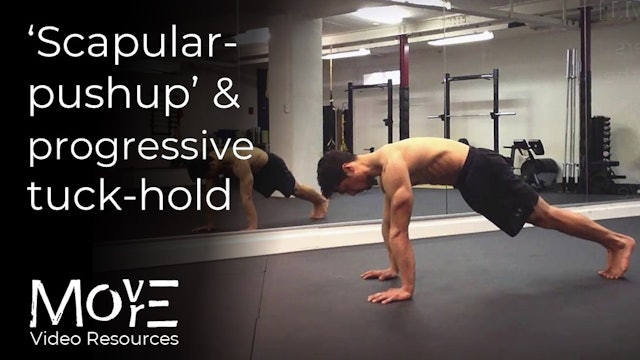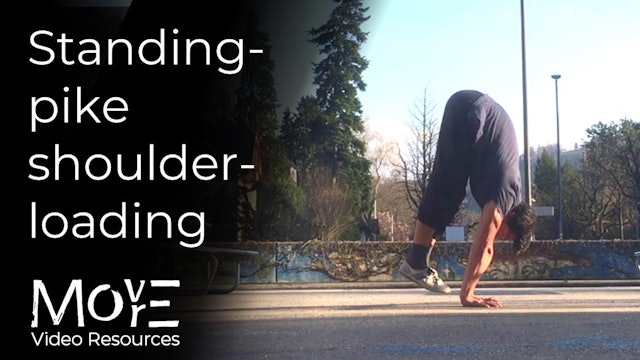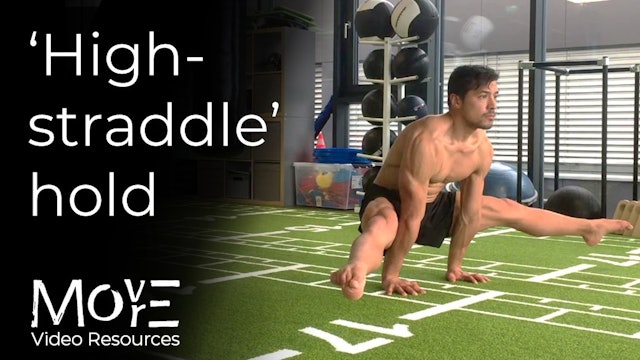SASS push (vertical & horizontal)
The straight-arm scapular-strength (SASS) ‘push’ collection develops the foundational understanding, patterning, and capacity on which to build the mechanics of straight AND bent-arm pushing through a progressive pathway. Whilst the function of the scapulae in SASS hanging/pulling contexts this is to “connect” arms-to-torso (and the rest of the body) so that it can be PULLED upward, in PUSH contexts the scapulae serve to establish & maintain a stable structure upon which to SUPPORT the weight of the body (i.e. PUSHING it upward AWAY from the floor).
This translates to the function & capacity to maintain an optimal scapular position to support a straight-arm push in different directions, ones more versatile than in SASS ‘pull’ contexts which have less potential for working with the body in different orientations. In SASS ‘push’, contexts include SUPINE (i.e. facing upward), VERTICAL (i.e. facing forward & pushing both DOWNARD as well as UPWARD), and PRONE (i.e. facing downward) body-positions.
LEARN MORE (subscriber-only):
https://drive.google.com/file/d/17covN9SQx6OeQvP6bbLX8vBp3htnmrj4/view?usp=drive_link
-
IN FOCUS: The Scapular Pushup
THE WHAT:
We take an 'in-focus' look at a fundamental straight-arm scapular-strength (SASS) exercise which forms the foundation of many upper body-weight movements. As well as UNIFYING strength, it mobilises & builds scapular mobility and develops coordination in its patterning.LEARN MORE (sub...
-
'Scapular Pushup' & progressive 'Tuck-hold'
THE WHAT (SCAPULAR-PUSHUP):
An upper-body mobilization, neuro-muscular & strength-development context form which expresses straight-arm scapular/strength (SAS/S), in horizontal pushing.Structurally, it represents and practices a global "hollow" of the body (slight flexion from head-to-toes, lik...
-
IN FOCUS: 'Lat-activated' scapular pushup & tuck-planche
THE WHAT:
Bringing attention to a subtle, yet significant, additional-intention which maximally "unifies" the strength of the upper-body "hollow" structure for transferability to the straight-arm 'Scapular-pushup' and 'Planche' variations, as well as bent-arm pushing such as the 'Protract-/Pike p... -
Unilateral / 1-arm pushing tools 1 (floor)
THE WHAT:
Contexts for developing an understanding of floor-based unilateral pushing in the horizontal plane. Focus is on differentiation between ROTATIONAL (RO) and ANTI-ROTATIONAL (AR) intention. Whilst the former, 'RO', is more efficient (it allows for & works with the body's natural tendency ... -
Unilateral / 1-arm pushing tools 1 (rings)
THE WHAT:
Contexts for developing unilateral pushing mechanics, patterning, and capacity using the more unstable modality of the gymnastics rings. These exercises are all characterised as ANTI-rotational (AR) patterns, requiring a sustained effort to keep the shoulders & hips in horizontal alignm... -
'Table-top' isometric variations
THE WHAT:
A fundamental straight-arm shoulder-extension context for mobility, strength, and structural-balance development (i.e. to "balance out" overhead pushing/shoulder-flexion contexts).Whilst the fundamental bilateral context (i.e. both hands & feet on the ground) helps to diagnose, develo...
-
The fundamental 'AG support'
THE WHAT & HOW:
The 'AG ('Artistic gymnastics') support' position allows for the development of strength to PULL and support oneself in the ranges of shoulder-extension. This is as opposed to the more passive range which is develop in shoulder-extension contexts, such as the 'German hang' positio... -
Fundamental 'P-bars' support to 'Pike-extensions'
THE WHAT:
Beginning with a fundamental, vertical-support position we develop straight-arm scapular-strength (SASS) in coordination with the global "hollow" structure. This structure is integral to nearly all bodyweight strength work, no matter straight-arm or bent-arm, nor the orientation of the ... -
Standing-pike shoulder-loading
THE WHAT & HOW:
These progressive 'shoulder-loading' variations are used to condition & strengthen the anterior shoulders & upper-back muscles, as well as hip-flexion & the abdominal "crunch" toward maximising 'compression' potential (the ACTIVE forward-folding strength compressing the upper-body... -
L-sit to V-sit progression
THE WHAT & HOW:
'THE L-SIT' represents another fundamental bodyweight-strength (BWS) form whereby the load of the body in its entirety is held off of the floor. That it begins in a seated position and utilises a scapular pushing mechanic with much greater "real-world" application than other BWS f... -
Parallettes 'Planche' & 'L-/V-sit'
THE WHAT:
Developing these two fundamental SAS/S forms on the low-parallettes (or optionally high 'Parallel-bars') is essentially just a shift of modality from floor, to bar-support.Despite this apparently small difference, it can affect execution quite significantly depending on the individual...
-
Fundamental 'Ring-support' variations
THE WHAT:
Fundamental 'Ring-support' variations & progressions for developing stability & straight-arm strength in a vertical push context on the gymnastics rings.As well as developing structural awareness (namely of the slightly PROTRACTED and HOLLOWED local & global form) and accustoming to t...
-
High straddle-hold
THE WHAT:
An integrated straddle-compression (i.e. active lifting of the extended legs) and straight-arm scapular-strength (SASS) drill in the context of vertical pushing. Ultimately, these two aspects integrate into a fundamental isometric form which both serves for strength-conditioning and 'ac...















